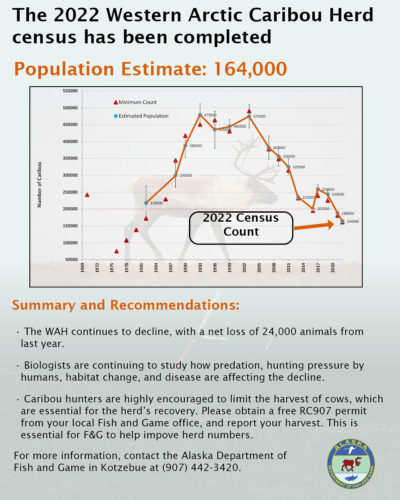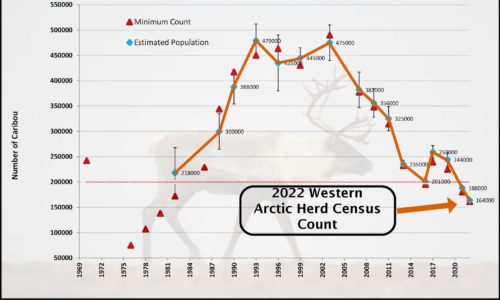
Western Arctic Caribou Herd Population Drops Again
Alaska’s famed Western Arctic Caribou Herd numbers continue to decline. Alaska Department of Fish and Game posted this Facebook report last week:


As the graph shows, after an uptick in 2014 the numbers have been steadily dropping since around 2017-18.
Here’s more from the Anchorage Daily News, which focused on the concerns subsistence hunters will have if those opportunities are decreased:
The new data from the Alaska Department of Fish and Game shows that the Western Arctic Caribou Herd population is down to an estimated 164,000 animals — an almost 13% decrease over the past year. The estimate dropped from 259,000 caribou in 2017 to 244,000 in 2019 and to 188,000 in 2021.
“It’s going to be another rough winter again this year without caribou,” Selawik resident Norma Ballot said. “It’s affecting our people, especially our elderly people, that don’t go out to hunt, and our younger people used to share” their harvest with them.
The herd is a traditional subsistence resource for Northwest Alaska, as well as the western North Slope communities, that’s healthy and affordable.
Alaska Public Media posted this Alaska Beacon piece:
The herd is important to Indigenous villagers in northern Alaska who depend on the animals for food and for cultural traditions. That potentially makes the herd’s decline a problem.
“I can’t say that it isn’t concerning. It depends on what your needs and purposes in life are,” Hansen said. There has been local concern expressed about the caribou’s present population, he said, “because folks rely on them.”
The herd has been at the center of a debate over the proposed Ambler Mining District Industrial Road, a 211-miles project that would cut through the Brooks Range foothills – and a large swatch of the caribou’s range – to connect an isolated copper-mining district with Alaska’s existing road system.



